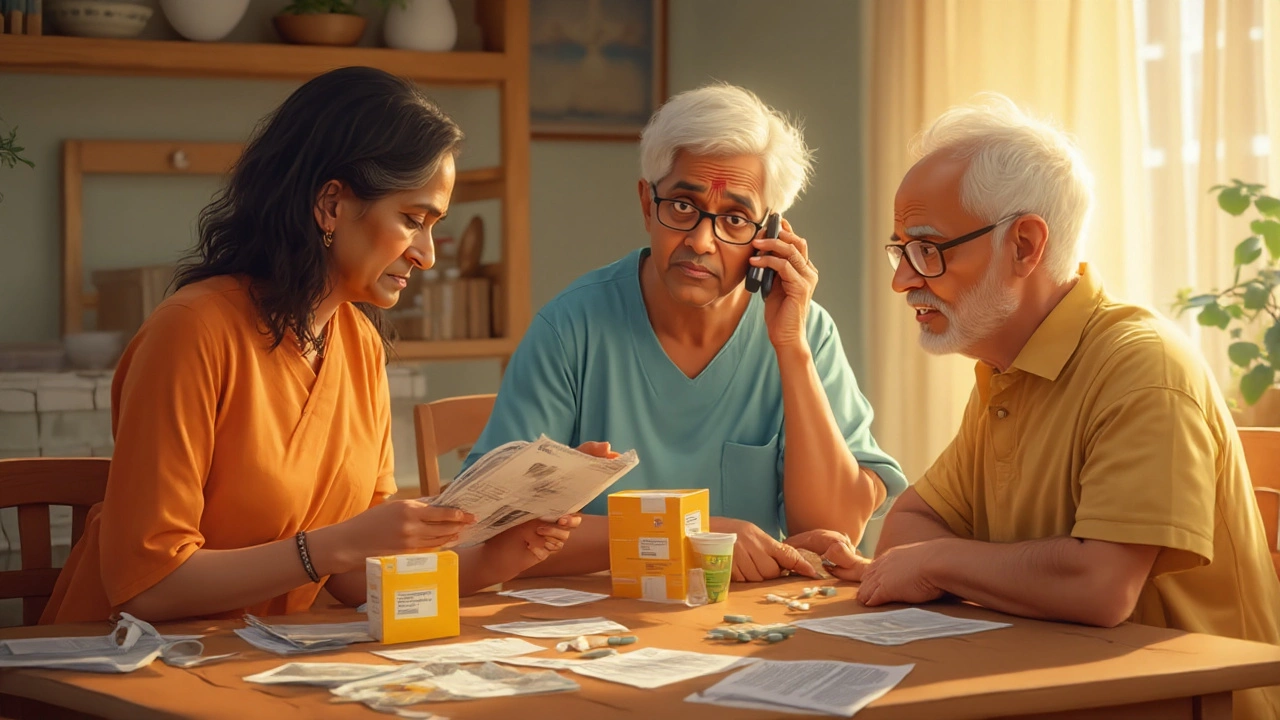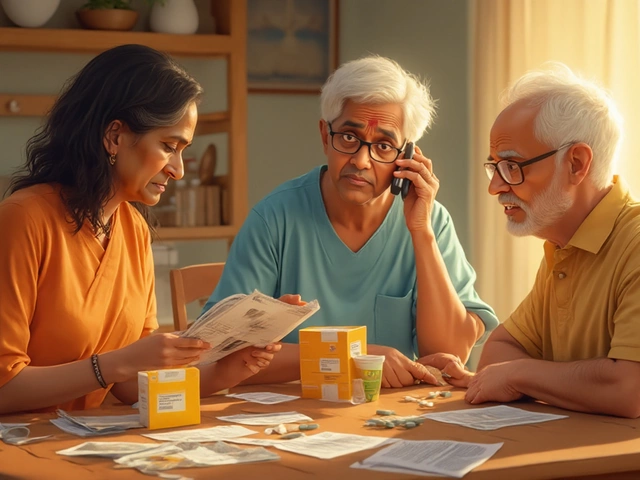
Mail-Order Pharmacy Risks: What You Need to Know Before Switching
Ever had a prescription show up at your door and thought, "Wow, that was too easy"? The rise of mail-order pharmacies has been a game-changer for people looking to skip the queue at the chemist. Sign up with a few clicks, auto-refills keep the meds coming, and sometimes, you save money. But there’s a flip side not everyone talks about. While the convenience is obvious, many don’t realize that handing over your prescriptions to the internet comes with some sneaky drawbacks that could mess up your routine—or even your health.
The Convenience Trap: Where Speed Meets Snags
It’s hard to argue with the appeal of getting your medicines shipped straight to your place. No awkward small talk with the pharmacist. No chilly walks to Boots or waiting in line when you’re feeling rubbish. But all this convenience can make it easy to miss what’s slipping through the cracks. For starters, mail-order means you’re now dealing with a postal system that’s not exactly famous for reliability. Packages get delayed, misplaced, or left in the rain. The UK’s Royal Mail has solid coverage, but plenty of folks have had parcels go on mysterious journeys or show up weeks late—especially during strikes or bad weather.
Here’s something most don’t think about until it happens: you run out of pills because your delivery is delayed. Suddenly, you’re making panicked calls to your doctor, or you have to buy an “emergency” blister pack at a local pharmacy at cost. Diabetics who miss insulin, or patients on heart medication who run out even for a day, face scary risks. Think about people who take antidepressants or anti-seizure meds—the clock doesn’t stop just because your package does.
Another hassle? Packages need to be signed for, or end up with neighbors. When NHS guidelines already stress privacy, it’s odd to have prescription labels floating about in someone else’s letterbox or at the local shop. Not a huge deal for some, but if you’re managing a condition you’d prefer to keep private, this can feel intrusive.
Temperature is another sneaky issue. Many medicines—think insulin, certain eye drops, and biologics—can lose their punch if they get too hot or cold. Packages left outside, stuffed into an office mail pile, or stuck in a Royal Mail warehouse during a July heatwave aren’t exactly getting the best storage. The Royal Pharmaceutical Society points this out, and yet most mail-order services don’t guarantee climate control for regular deliveries.
If you’re tempted to sign up for an auto-refill scheme, here’s something to chew on: it’s super easy to lose track of which meds are current, which are duplicate, and which have changed after a doctor’s tweak. A 2023 study in The Pharmaceutical Journal found that about 16% of people using auto-refill mail-order services received unwanted refills or ended up stockpiling old meds. That’s money gone, and it clutters up your cupboard, not to mention the growing problem of opioid and antibiotic waste.
Now, some insurers or NHS trusts make mail-order almost unavoidable by offering deals or requiring certain scripts to be filled online. It seems simple: save a few quid and a trip to town. But what’s not pointed out is the hassle when you need to urgently change your script. Traditional chemists let you walk in with a new script and walk out with pills in minutes. Mail-order? That’s several days at best, usually with paperwork involved. Not exactly what you need if you just saw your GP and need a new dose today.
| Issue | Potential Impact | Percentage of Users Affected (2023) |
|---|---|---|
| Delayed Delivery | Missed doses, emergency refills needed | 24% |
| Unwanted Auto-Refills | Stockpiling, wasted meds, extra costs | 16% |
| Temperature Issues | Reduced medication effectiveness | 10% |
| Lost Packages | Health risks, data breaches | 6% |
| Lack of Privacy | Stigma, anxiety | 8% |
Communication Gaps: Less Chat, More Guesswork
If you’ve used a high street chemist for ages, you probably recognize the staff, and they know you. Pop in for your refill and they ask if you’re noticing any weird side effects, or double-check an odd dosage on your prescription. With online pharmacies, there’s much less of this. Sure, most of them say you can call their helpline, but speaking to a real pharmacist—even over the phone—takes longer and feels less personal. That “gut feeling” advice about a dodgy side effect or how to space meds sometimes disappears in a web form or an email.
According to an NHS Digital report, users of mail-order services are about one-third less likely to have face-to-face pharmacist consultations compared to retail pharmacy customers. This may sound like a small thing, but lots of people, especially those new to a prescription, get confused with instructions. Think about starting warfarin or a new thyroid medication. If you’re not confident making sense of the leaflet, you used to just ask. Now? You’re digging through FAQ pages and hoping the chatbot understands you.
Some conditions need extra care. Blood thinners, anti-epileptics, and certain cancer drugs have lots of interactions and can be dangerous if taken the wrong way or with new meds. There’s a reason pharmaceutical councils keep hammering on about medication reviews—these crucial catch-ups are less likely to happen if “your pharmacist” is just a name on an email footer.
And when it comes to patients with multiple conditions, postal errors can be a nightmare. Maybe a GP tweaked your dose, but the pharmacy never got the memo—so the wrong amount shows up, to your letterbox or worse, a neighbor’s. People juggling several scripts are especially at risk for mistakes in the mail, compared to those who pick up set packs each month and can clarify things face-to-face.
Now, most online pharmacies want to do right by their customers and have properly trained staff. But not all mail-order providers are regulated by the General Pharmaceutical Council (GPhC), especially with rising gray-market websites. Counterfeit medications and knockoffs are a genuine risk, and watchdog groups like Medicines and Healthcare products Regulatory Agency (MHRA) have issued warnings about sites masquerading as legit. If you’re using a recommended NHS service, you’re probably fine, but the temptation of cheap drugs online isn’t always harmless.
Just to throw in some numbers: a 2022 YouGov poll showed that 38% of Britons surveyed were “very concerned” or “cautious” about trusting new or little-known online pharmacies. Around 21% had received emails from dodgy-looking sites promising cheap prescriptions with no checks. The best rule: if it looks too good to be true, it probably is—and it could be dangerous.
So, while the speed of online scripts can be a lifesaver for some, the lack of real conversation with a human can be a hidden cost. The stuff you don’t know, and can’t Google, is what tends to catch you out.

Cost Myths, Insurance Quirks, and Hidden Fees
The promise of discounts and savings drives tons of people to switch to mail-order pharmacy services. It’s true—sometimes you score a better deal on bulk refills, or you dodge repeat pharmacy “handling” charges. But lots of UK NHS and private insurers have complicated rules about what’s covered, and how often you can claim mail-order meds. It all sounds simple on the surface, but there are little quirks that add up. Find a site that isn’t in the right insurance network, and you could end up stuck with the bill.
One thing most people don’t realise: some mail-order pharmacies work with overseas suppliers to cut costs. That’s usually fine, but with border delays, customs checks, or supply chain hiccups (just look at what’s happened with Brexit and medicine shortages since 2021), your orders might suddenly take much longer, get hit with extra fees, or—even worse—be held up by customs until you submit more paperwork. Meanwhile, you’re without your pills.
Here’s a real-world stat: a 2023 NHS England review found that 6% of patients switching to mail-order pharmacies faced surprise customs fees or order rejections due to changes in post-Brexit import rules. That doesn’t sound like a big deal until you’re the one caught out, paying double the expected cost just to get your meds cleared.
And don’t forget, newer medications or specialist drugs may not be eligible at all for mail delivery, especially if they require close monitoring. Think chemotherapy tablets, injectable biologics, or controlled substances—most aren’t legally posted for at-home delivery without special arrangements, so you’ll still need to visit the hospital or pharmacy in person. It’s easy to assume you can get everything shipped, but that’s rarely true for rarer conditions.
Some mail-order services sneak in extra “administrative” fees or subscriptions that eat into any savings you might have expected. You might sign up for free delivery, not realising that’s only for standard prescriptions and doesn’t include urgent or cold-chain meds. Suddenly, what looked like a half-price deal’s barely cheaper (if at all) than picking things up down the street.
Pharmacy loyalty schemes are another quirk. Traditional high street chemists have points cards or rewards for regulars—that’s cash in your pocket if you stick with them. Mail-order services don’t usually play that game. It’s not a dealbreaker, but if you get regular scripts, that’s money you’re not getting back.
Who Should and Shouldn't Use Mail-Order Pharmacies?
Now, not all mail-order pharmacy pitfalls hit everyone equally. For folks who take long-term, stable meds—think blood pressure tablets, cholesterol pills—it makes sense to streamline life with home delivery. But who’s most at risk of mail-order downsides? Short answer: anyone whose prescriptions change often, need urgent fills, or use meds that are tricky to ship safely.
If you’ve just been diagnosed with a new condition, or your doctor is still figuring out the best dose—that’s a risky time to trust the post. People with memory problems, mental health struggles, or who live with unreliable mail delivery (think flats with communal mailboxes) should think twice. These are the ones most likely to run out, miss a prescription change, or get tangled up with duplicate meds.
Parents of kids with serious allergies or asthma often stick to local chemists. If your child suddenly needs an EpiPen refill or a new inhaler after a GP visit, waiting on a package won’t cut it. The same goes for people managing diabetes types that need regular insulin tweaks, or the elderly who depend on regular medication reviews to catch issues before they get dangerous.
On the flip side, people who travel for work or have trouble making it to the pharmacy might find mail-order a lifesaver—if they stay on top of delivery timelines and use regulated firms. A good tip: always keep at least a week’s buffer of meds, just in case a shipment goes missing. Your GP can usually issue a one-off emergency prescription if you explain the circumstance, but that takes time, and not every surgery does same-day scripts.
If privacy is a big concern, check if the pharmacy uses discreet packaging or sends meds to click-and-collect points. Ask your GP if they can send prescriptions automatically to both your usual pharmacy and your mail-order supplier for extra backup. Tricky, but it works for some. And always use a provider clearly registered with the GPhC—look for the green internet pharmacy logo on their site. Don’t be tempted by the cheapest online price, especially for new or unlicensed drugs.
- Double-check refill dates and keep copies of your prescriptions.
- Ask for tracking numbers on sensitive or expensive parcels.
- Don’t hesitate to use local pharmacies for urgent scripts.
- If you get a medicine that looks different from usual, call straight away to confirm it’s correct.
- Never share prescription details with unverified sites.
The future of pharmacy is probably going to be a blend of both—some scripts direct to your letterbox, others handled in person. Knowing the quirks and downsides helps you sidestep surprises and keep your health on track, no matter where your meds are coming from. Sure, the world’s moving online, but when it comes to your body, there’s still room for a good old-fashioned conversation with a real-life, local pharmacist.

Arnav Singh
I am a health expert with a focus on medicine-related topics in India. My work involves researching and writing articles that aim to inform and educate readers about health and wellness practices. I enjoy exploring the intersections of traditional and modern medicine and how they impact healthcare in the Indian context. Writing for various health magazines and platforms allows me to share my insights with a wider audience.
About
Medical Resource Center India is a comprehensive online platform dedicated to providing reliable health information and medical resources in India. Explore a wide range of articles, tips, and advice on medicine, healthcare services, and wellness. Stay informed about the latest developments in Indian medicine and access valuable insights into maintaining a healthy lifestyle. Discover expert guidance and health solutions tailored for every Indian citizen. Your go-to destination for authoritative medical knowledge in India.








